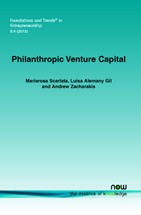Philanthropic Venture Capital: Venture Capital for Social Entrepreneurs?
By Mariarosa Scarlata, Newcastle University, UK, mariarosa.scarlata@newcastle.ac.uk | Luisa Alemany Gil, ESADE, Spain, luisa.alemany@esade.edu | Andrew Zacharakis, Babson College, USA, zacharakis@babson.edu
Abstract
Since social entrepreneurship is a relatively young activity, resourcerich actors, like Philanthropic VCs, have considerable influence over how the space matures (Nicholls, 2010b). The resources and strategic advice that PhVCs provide their SEs shape an institutional logic for the domain. As such, PhVCs enhance legitimacy of the emerging area of social entrepreneurship. This monograph's main contribution is to delineate the current state of PhVC, identifying differences with traditional VC financing, and identify areas of future research. In particular, this work responds to Nicholls (2010b) and Austin et al.'s (2006b) call for research on what types of finance SEs have access to. More specifically, we focus on understanding what PhVC is and how its social value creation investment logic makes it different from traditional VC, opening avenues for future research in this area.
Philanthropic Venture Capital
Philanthropic Venture Capital: Venture Capital for Social Entrepreneurs? aims to delineate the current state of philantropic venture capital, identifying differences with traditional venture capital financing, and offers directions for future research. It focuses on understanding what philanthropic venture capital is and how its social value creation investment logic makes it different from traditional venture capital. The monograph starts with a definition of philanthropic venture capital. Second, an overview of financing available for social entrepreneurs is discussed focusing on those characterized by a level of investor engagement. Third, data on the philanthropic VC sector in the United States and Europe is presented in terms of age of the sector, legal form of the philanthropic venture capital firm, capital under management and location of portfolio organizations. Fourth, investment practices implemented in philanthropic venture capital are identified according to the different phases of the investment process in traditional venture capital and further research opportunities are identified. The paper concludes drawing implications for both academics and practitioners.
